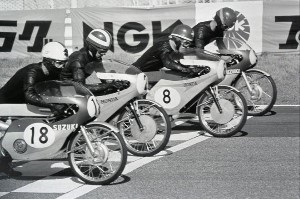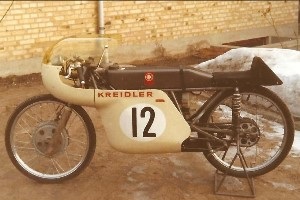
 |
The story of 50cc roadracing |
 |
|
THE BEGINNING
After the 2nd world war, a lot of countries, both in Europe and in the East, were in dire financial straits, and people lacked the money to buy a car or even a decent motor cycle, and this gave rise to the development of inexpensive 50 cc mopeds and simple scooters. The mopeds were first merely bicycles with an auxiliary engine, like e.g., the Solex and the clip-on engine Mosquito, but soon developed into more sophisticated bikes, although still very basic, having no gearbox and mostly no rear suspension. Later they got often a two-speed gearbox, and rear suspension, and grew often into rather luxurious mini-motorcycles. Countries with the most popular brands were France (Solex, Motobecane "Mobylette", Peugeot, Gitane, VAP, Terrot, etc.), Germany (Kreidler, Zündapp, Victoria, RAP, HMW, DKW, Maico, etc.) and Holland (Sparta, Cyrus, Avaros, Locomotief, Eysink, Batavus, DMF, Berini, Magneet, Pon, Union, Avada, Gazelle, Union - the list is really very long, in Holland the moped was very popular), and there were also some Belgian (Flandria, Royal Nord, FN), and a host of Italian mopeds, which were popular mainly with the young people because of their sporty appeal (Demm, Ducati, Alpino, Morini-Guilietta, Benelli, Motom, Garelli, Testi, Capriolo, Malanca, Paloma, Mondial, etc.) Young people, being what they are, soon began to organize competitions, first on a local basis. This grew to national events, and then to international races in Western Europe, where most races were organized in Germany, Belgium, France, Holland and Great Britain. This became so popular, that the FIM decided to have a Coupe d' Europe for 1961 (duly won by Hans-Georg Anscheidt on a Kreidler), and a year later the 50 cc class was given world championship status. J.Kortekaas 2006 |
 |
 |
 |
 |
| THE CHAMPIONSHIPS | THE MACHINES | ENGINEERING | 50cc RECORDS |
